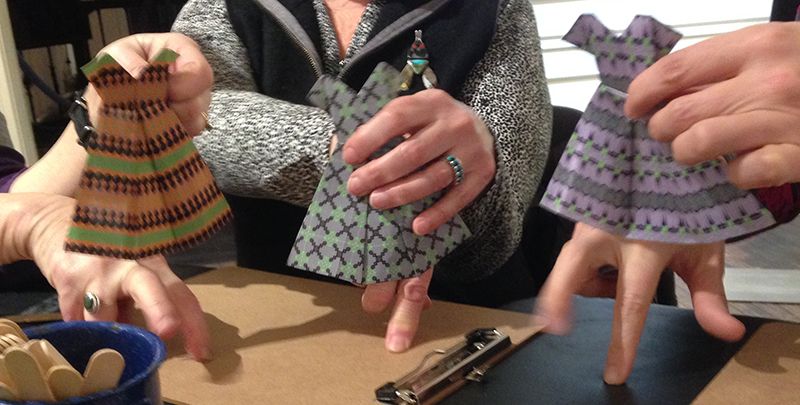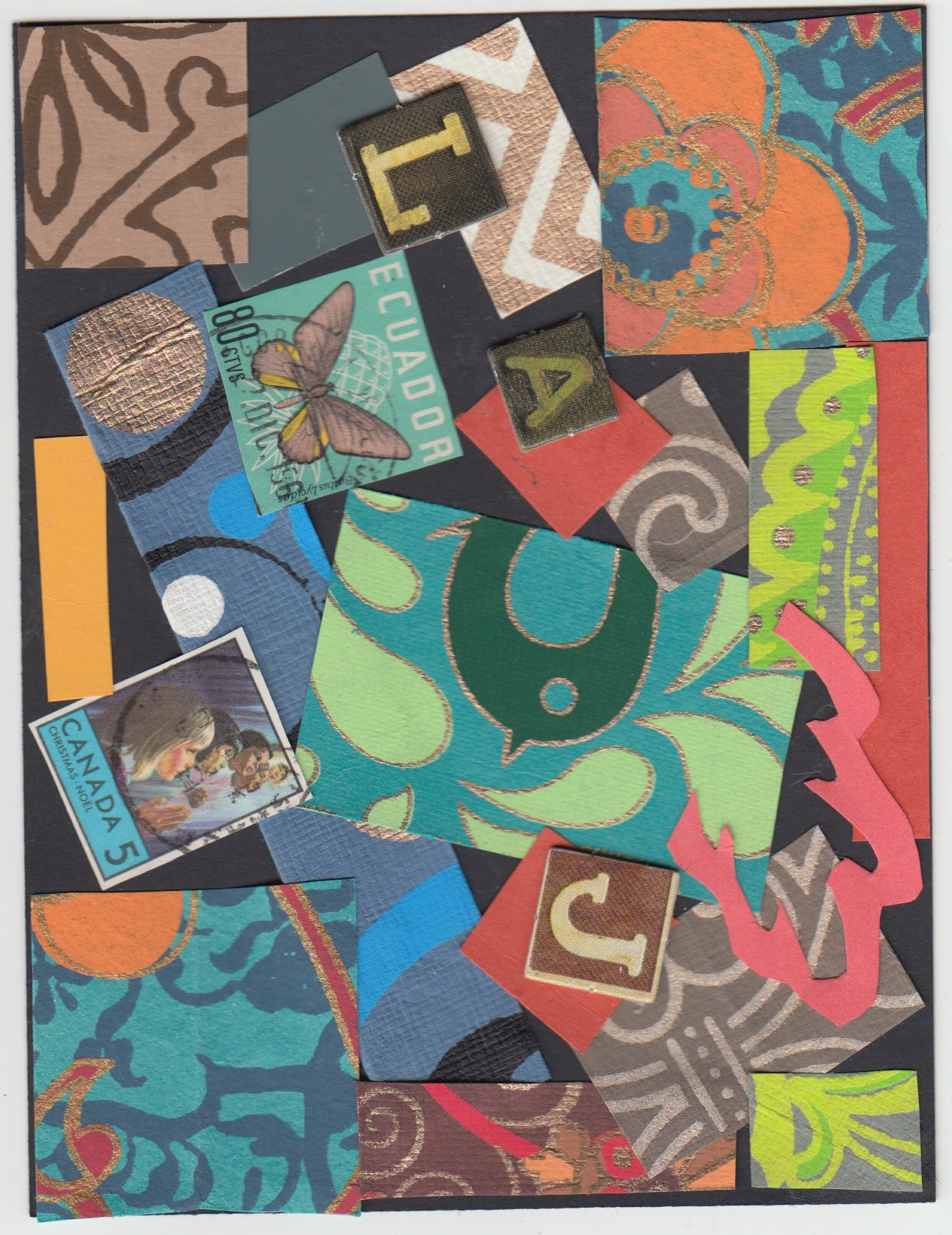Last year, I got a grant from the state arts board to make some new work. Part of the requirements of the grant was to have a part of the project that the public could participate in. This could be a performance to attend, art making, a video to watch. Something that they could interact with in some way.
I chose to do a series of mini-workshops where I showed participants how to do a tiny taste of my process making the art for the exhibition that was the culmination of the grant. The workshops were well attended and I had so much fun. A friend recently did a similar series of art making workshops for another grant. She posted about her nervousness and excitement about the events and one of the commenters on that post of hers really stood out for me. The comment was something like this:
“You are so brave. I could never do an event like that, I would be too scared that nobody would show up.”
I read that comment and I thought to myself, “Oh honey. Nobody always shows up. You can count on that.”
 When I say “nobody” I don’t mean literally nobody. I mean that you never know exactly who is going to show up and it is never going to be who you think it is. I do a lot of art making events and residencies and pop-up kinds of things in many different venues because I love it, but the reality is that:
When I say “nobody” I don’t mean literally nobody. I mean that you never know exactly who is going to show up and it is never going to be who you think it is. I do a lot of art making events and residencies and pop-up kinds of things in many different venues because I love it, but the reality is that:
- 80% of the time there are fewer people there than I would wish for
- 5% of the time there are way more people than I am prepared for
- 5% of the time there is just me and the crickets (or it’s cancelled altogether)
- Which leaves about 10% of the time that the class is actually living up to what I pictured in my head
I often don’t know what category an event is going to fall into until I show up. About 25% of the classes I offered this year were cancelled due to low enrollment. At least one event that I had scheduled, the venue forgot I was even coming. I have had events this year that have sold out/filled up in just a few hours and ones that were teetering on the edge of being cancelled for weeks. Sometimes they snowball and a class gets cancelled on a weekend when I turned down other things, since I can’t be in two places at once. (And now I have no events instead of too many.)
The thing I had to learn is that the number of people that show up isn’t the most important part. Numbers don’t equal success. Numbers don’t equal value. Numbers don’t equal quality. And that’s hard to wrap your head around.
I worked at an art center for more than 11 years and I was in charge of scheduling classes and workshops and having to make the call when something would run or be cancelled. One of my “rules of thumb” was that pretty often, the first time you offered a new class it would not have enough students registered to be able to run but the second time it was offered, it would fill up. I can’t explain why with any certainty, but I have a feeling that it was some subtle psychology. There is a marketing theory, called the “Rule of Seven”, that says for an ad or message to be effective, you the consumer, have to see it 7 times before you will take action. I think that totally happened with these classes. By the time it was offered a second time, it seemed familiar and reminded that potential student that this was something that looked amazing the first time they read about it.
Think about it. The reasons for you to not do something (like sign up for a class) pretty much always outnumber the reasons to do it: you don’t have time right now, you shouldn’t spend the money right now, you don’t know the teacher and you aren’t sure you will like it, there’s so much else needing your attention….
And you know what? None of those reasons have anything to do with me, the artist who is offering this class or performance or art making event.
 I did several art-making-in-the-gallery events when my exhibition was on display. I was there one afternoon for about 3 hours and I had four people show up for the activity. Four seems kind of depressing. But that group of four was delightful. We did the art project. No one was waiting, so we made another and everyone got to practice a second time. They took pictures, we posted to social media, we laughed and talked about all kinds of other creative ideas that they had while they were working. This was 6 months ago and I still think of that group and smile. There were several dozen other people who “said they were interested” in the event on Facebook or liked the post that I wrote about it. It went out in newsletters and postcards and word of mouth. Not everyone is going to be interested. Not everyone is even going to pay attention. But for those four people, the balance tipped the other way and the reasons to go do it outweighed the reasons not to and that, when you think about it, is something to celebrate.
I did several art-making-in-the-gallery events when my exhibition was on display. I was there one afternoon for about 3 hours and I had four people show up for the activity. Four seems kind of depressing. But that group of four was delightful. We did the art project. No one was waiting, so we made another and everyone got to practice a second time. They took pictures, we posted to social media, we laughed and talked about all kinds of other creative ideas that they had while they were working. This was 6 months ago and I still think of that group and smile. There were several dozen other people who “said they were interested” in the event on Facebook or liked the post that I wrote about it. It went out in newsletters and postcards and word of mouth. Not everyone is going to be interested. Not everyone is even going to pay attention. But for those four people, the balance tipped the other way and the reasons to go do it outweighed the reasons not to and that, when you think about it, is something to celebrate.
When I say that 80% of the time there are fewer people there than I would wish for it’s not because the number is important by itself. It’s because I want to share that kind of experience with more people. That’s why I love teaching. It’s because there is something magic that happens when you have just the right size group to build some energy and spark conversation, where people feel like they can contribute without feeling self-conscious. A class of 3 people rarely hits that magic groove, but a class of 8 or 12 can be amazing. (A class of 50 rarely hits the magic groove either. It goes both ways.) Sometimes I wish for more students because the flat out financial logistics don’t work out if you don’t get enough. Then I am paying the venue more than I am making in order to use the space. That is difficult to sustain. Sometimes I wish for more because I want to build momentum. If more people took my beginning class, I would have the push and demand to develop the next more advanced one. And that’s fun for me and for my students too.
I feel like every day in my Facebook or Twitter feed there is a promo post from someone for how to grow your numbers. Number of followers or likes or shares or retweets. As if the number is going to magically make you successful and if you aren’t getting enough likes you are a failure. I think that blog commenter I mentioned at the beginning of this post had this same feeling: She couldn’t even do it, because if no one showed up then she would be a failure. I get it. If I looked at every cancelled class or low attendance as failure, I couldn’t do it either.
Instead, I try to think of it this way: Getting 100 “likes” is like getting a round of applause. It’s fun and very satisfying but it’s over in 23 seconds and everyone has moved on. But I would trade those 100 likes for another mini class with the four ladies from the gallery. Every time.
There’s a quote (with an original source which is highly debated) that says “It’s not the years in your life that matters; it’s the life in your years”. I am pretty sure that applies: It’s not the numbers in your class that matters, it’s the class with those students.







